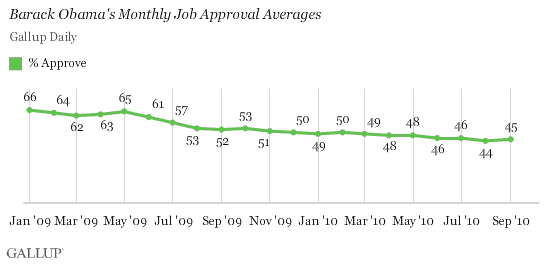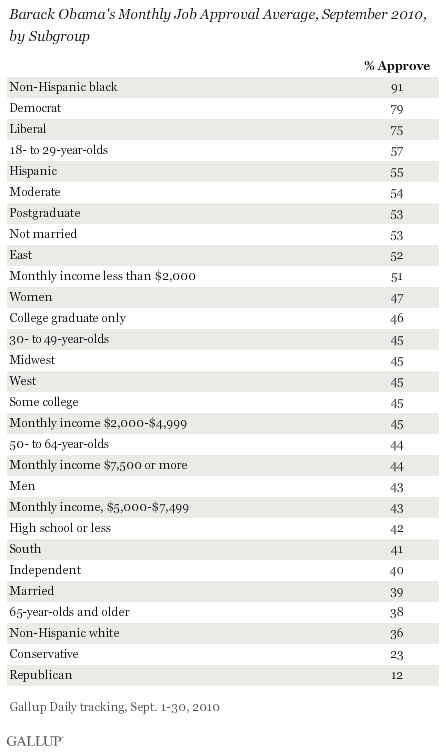PRINCETON, NJ -- President Barack Obama's job approval ratings remain below 50%, with an average 45% job approval score for the president in September. That is a slight improvement from his term-low 44% average in August.

More generally, Obama's approval rating has not exceeded 50% in any month this year. Also, he has not had an approval rating above 50% in any Gallup Daily tracking three-day rolling average since mid-May.
These are troubling signs for the Democratic Party as presidents below 50% approval at the time of midterm elections typically see their party lose a substantial number of seats.
With his public approval solidly below 50% in September, it follows that less than a majority in most key demographic subgroups approve of the job the president is doing. His staunchest supporters remain blacks (91%), self-identified Democrats (79%), and self-identified liberals (75%).
Several other groups, all tending to be Democratic in their political orientation, give Obama approval ratings just above the majority level. These include young adults, Hispanics, Eastern region residents, political moderates, those who are unmarried, those with a postgraduate education, and those in the lowest income bracket.
Obama's approval ratings among whites (36%) and senior citizens (38%) continue to lag those from most other demographic groups.

Bottom Line
Presidents' approval ratings at the beginning of October in their first midterm election year are generally similar to what they will be at the time of the election. Richard Nixon is the only president whose rating improved significantly (from 51% to 58%) in the final weeks leading up to his first midterm election. If Obama's approval rating does not improve in the coming weeks, his support will be similar to that of Ronald Reagan (42% in 1982) and Bill Clinton (45% in 1994), both of whose parties suffered substantial congressional losses in the midterm election.
Survey Methods
Results are based on telephone interviews conducted as part of Gallup Daily tracking survey Sept. 1-30, 2010, with a random sample of 15,200 adults, aged 18 and older, living in all 50 U.S. states and the District of Columbia, selected using random-digit-dial sampling.
For results based on the total sample of national adults, one can say with 95% confidence that the maximum margin of sampling error is ±1 percentage point. Margins of error for subgroups will be higher.
Interviews are conducted with respondents on landline telephones and cellular phones, with interviews conducted in Spanish for respondents who are primarily Spanish-speaking. Each daily sample includes a minimum quota of 150 cell phone respondents and 850 landline respondents, with additional minimum quotas among landline respondents for gender within region. Landline respondents are chosen at random within each household on the basis of which member had the most recent birthday.
Samples are weighted by gender, age, race, Hispanic ethnicity, education, region, adults in the household, cell phone-only status, cell phone-mostly status, and phone lines. Demographic weighting targets are based on the March 2009 Current Population Survey figures for the aged 18 and older non-institutionalized population living in U.S. telephone households. All reported margins of sampling error include the computed design effects for weighting and sample design.
In addition to sampling error, question wording and practical difficulties in conducting surveys can introduce error or bias into the findings of public opinion polls.
For more details on Gallup's polling methodology, visit https://www.gallup.com/.
